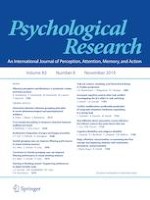23-04-2018 | Original Article
Starting or finishing sooner? Sequencing preferences in object transfer tasks
Gepubliceerd in: Psychological Research | Uitgave 8/2019
Log in om toegang te krijgenAbstract
When tasks are performed, other tasks are postponed, at least implicitly. Little is known about how task sequencing is determined. We examined task sequencing in object transfer tasks for which either task could easily or logically come before the other. The task was to transfer ping pong balls from two buckets into a bowl. To perform the task, participants walked down a corridor, picked up one of two buckets (their choice), carried it to the end of the corridor, transferred the balls from the bucket into a bowl, carried the bucket back to the start position, and then did the same with the other remaining bucket. As in an earlier study where just one of two buckets had to be carried to the end of a corridor (Rosenbaum et al. Psychol Sci 25(7):1487–1496, 2014), participants showed a marked tendency to start with the near bucket. The near-bucket preference was modulated only to a small extent by the number of balls that could be emptied into the bowl. The relative lack of importance of the number of balls to be transferred (to finish the first task more quickly or to get closer to the end goal of transferring all balls into the bowl) was further demonstrated by the fact that the effect of the number of balls to be transferred did not depend on how the emptying was supposed to occur (by pouring the balls or placing the balls one at a time into the bowl), or by whether the instruction focused on filling the bowl or emptying the buckets. The results suggest that the near-bucket preference reflects a strong inclination to start the task (sub-goal) as soon as possible rather than complete the task (sub-goal) as soon as possible. Starting the task as soon as possible may be related to the affordance triggered by the sight of the near object or by the freedom to perform without having to inhibit a reach for a bucket when the performer is empty-handed. Starting a task sooner may free up cognitive resources for subsequent decision-making.
